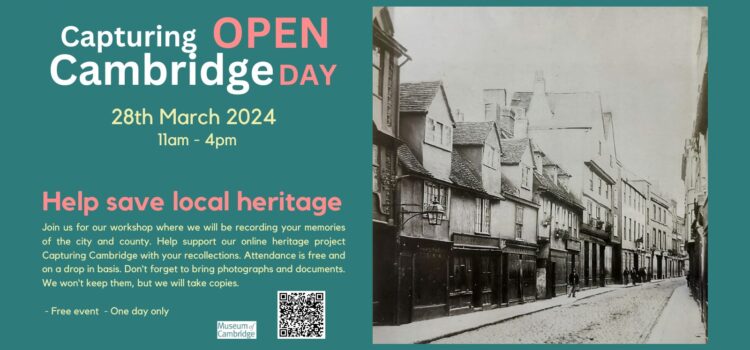Capturing Cambridge Open Day on 28th March was set up as a one-day event to allow locals of Cambridge city and the wider county the opportunity to record and share their histories. Created as an in-person event to support the Capturing Cambridge project, members of the public were encouraged to bring along any pictures or documents to help tell their stories about the schools they studied or the places they worked in Cambridge.
Capturing Cambridge is an ongoing project that collects information about Cambridge and Cambridgeshire onto a user -friendly map-based website. Run by the Museum of Cambridge, it collects data from censuses, newspapers, family history, photos and maps, and links this information to locations on the map. Learn more here: Capturing Cambridge | Discover Cambridge through the ages.
Whilst Capturing Cambridge Open Day was organised to collect information from the public in person, contributions are always very welcome. Information can be sent to the project at any time via email, or meetings can organised with those interested in sharing their family histories with the project. For those interested, contact Roger Lilley (roger.lilley@museumofcambridge.org.uk).
Roger Lilley, Chair of the Trustees, recalls about the Open Day:
“Our Open Day might not have been as busy as we might have liked, but it certainly turned up a treasure trove of information, mainly about the Heffer family, thanks to a member of the family who came in with his smartphone stuffed with photos that he proceeded to share with us.
William Heffer was certainly out of the same mold as those other 19th century men who, like Josiah Chater, came from humble origins but were determined to better themselves. William Heffer was the founder of the famous Cambridge business of printers and booksellers that survives to this day. He came from humble origins and despite a very basic education built up a family business that has become a household name in Cambridge. If you look at our entry for Fitzroy Street (Fitzroy Street (North Side) (East) | Capturing Cambridge) you’ll find his first shop at 104 Fitzroy Street and links to a family biography about him and other locations for the business he founded. There are other pages for successive premises, such as Petty Cury.”
A volunteer for the day, Kirsten, also discusses her experience from the day:
“Seeing [our visitor] Ruth light up as she shared her Cambridge story—that’s why I had signed up to volunteer at Capturing Cambridge Day. Having previously helped look after the museum’s physical collections as Collections Officer, I was excited to learn about collecting intangible oral histories, which enable the museum to tell new stories even when limited storage space makes it difficult to collect new objects.
Walking folks through the oral history collection form, I was walking with them through their memories of Cambridgeshire, from new family members to new jobs, from the changing face of work to the changing face of Cambridge and its villages. Moved by how animated Ruth was, I was struck by the power of telling one’s own story in and for a museum. Stories like Ruth’s that can help bring the museum’s digital and physical collections to life, and their telling puts—and empowers—new voices at the heart of the museum.”
Enid Porter, the Museum’s curator from 1947 to 1976, might have been able to collect oral histories as people dropped by the Folk Museum 50 years ago, but in 2024 the reality is that most of the many contributions we receive for Capturing Cambridge come via email as it is convenient and enables a quick exchange of ideas.
Do you have memories to share about your time living in Cambridgeshire? Contribute now to the Museum using this new online form.

After a few readings, he has a good understanding of most of the reading he does.
After a few readings, he has a good understanding of most of the reading he does.